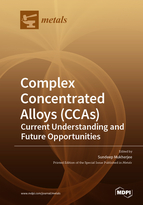Complex Concentrated Alloys (CCAs) - Current Understanding and Future Opportunities
A special issue of Metals (ISSN 2075-4701).
Deadline for manuscript submissions: closed (31 December 2019) | Viewed by 74925
Special Issue Editor
Interests: metallic glasses; high entropy alloys; advanced manufacturing; electrochemistry and corrosion; multi-scale mechanical behavior
Special Issues, Collections and Topics in MDPI journals
Special Issue Information
Dear Colleagues,
This Special Issue aims to present recent developments and future opportunities related to the topic of complex concentrated and high entropy alloys from fundamental aspects to various applications. Conventional structural alloys are single principal element systems with multi-phase microstructures. In that regard, complex concentrated alloys (CCAs), with multiple principal elements, represent a new paradigm in alloy design by focusing on the central region of a multi-component phase space rather than the edges. High configurational entropy leads to single-phase solid solutions in a certain subset of these multi-principal element systems, which have been termed as high entropy alloys (HEAs). However, the focus on a single-phase microstructure severely limits performance in real-world engineering applications. CCAs retain the “high entropy” nature of the parent matrix and add complex precipitates containing multiple elements on their respective sub-lattices as strengtheners. The core effects of high configurational entropy, lattice distortion and sluggish diffusion lead to a gamut of attractive properties including high strength-ductility combination, resistance to oxidation, corrosion/wear resistance, and interesting magnetic properties. For this Special Issue, contributions are welcome from experimentalists, theorists, and computational scientists in this field.
Specific topics of interest include (but are not limited to):
- Thermodynamics, kinetics, and phase transformation in multi-phase CCAs
- Mechanical behavior and deformation mechanisms
- Microstructure evolution as a function of processing
- Tribology, corrosion and oxidation behavior
- Magnetic and magneto-caloric properties
- Irradiation effects
- High strain-rate deformation behavior
- Simulation and modeling including DFT, MD, Phase-field, and CALPHAD
Prof. Dr. Sundeep Mukherjee
Guest Editor
Manuscript Submission Information
Manuscripts should be submitted online at www.mdpi.com by registering and logging in to this website. Once you are registered, click here to go to the submission form. Manuscripts can be submitted until the deadline. All submissions that pass pre-check are peer-reviewed. Accepted papers will be published continuously in the journal (as soon as accepted) and will be listed together on the special issue website. Research articles, review articles as well as short communications are invited. For planned papers, a title and short abstract (about 100 words) can be sent to the Editorial Office for announcement on this website.
Submitted manuscripts should not have been published previously, nor be under consideration for publication elsewhere (except conference proceedings papers). All manuscripts are thoroughly refereed through a single-blind peer-review process. A guide for authors and other relevant information for submission of manuscripts is available on the Instructions for Authors page. Metals is an international peer-reviewed open access monthly journal published by MDPI.
Please visit the Instructions for Authors page before submitting a manuscript. The Article Processing Charge (APC) for publication in this open access journal is 2600 CHF (Swiss Francs). Submitted papers should be well formatted and use good English. Authors may use MDPI's English editing service prior to publication or during author revisions.
Keywords
- Complex Concentrated Alloys
- High Entropy Alloys
- Alloy Design
- Mechanical Behavior
- Magnetic Properties
- Irradiation Effects






